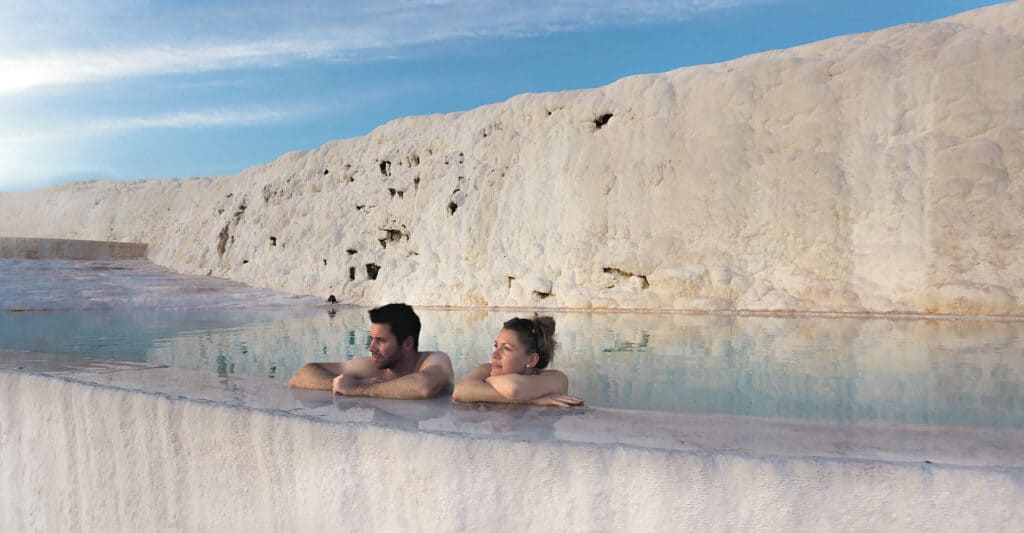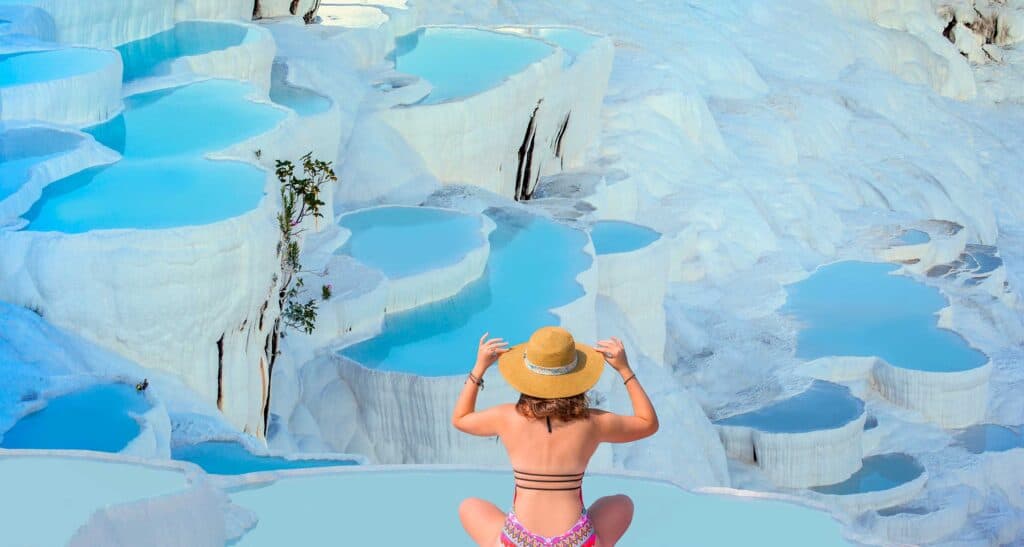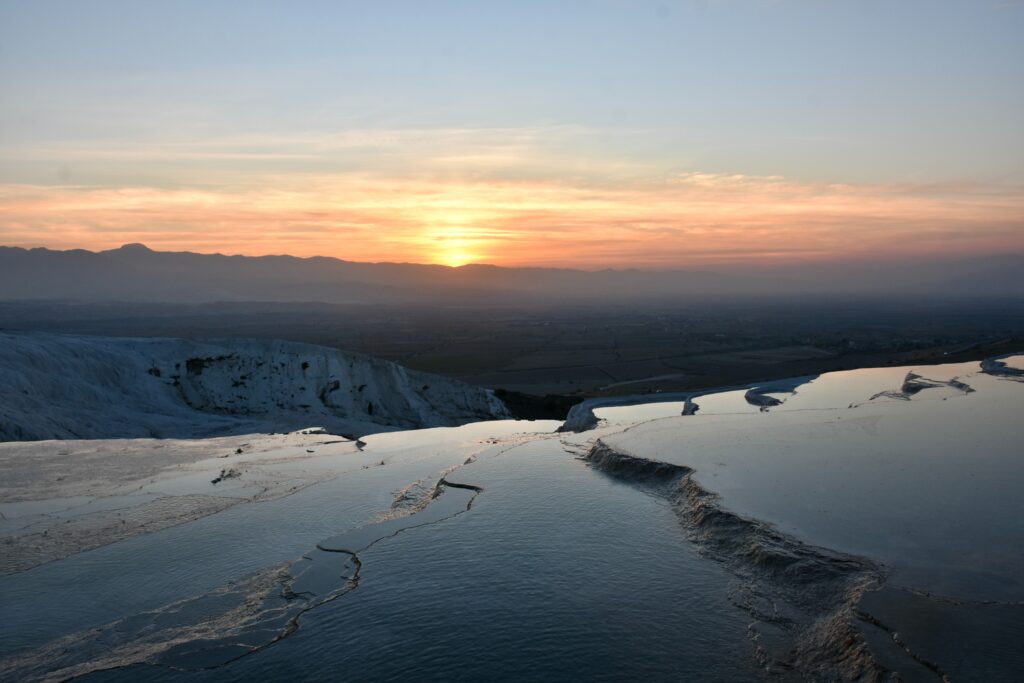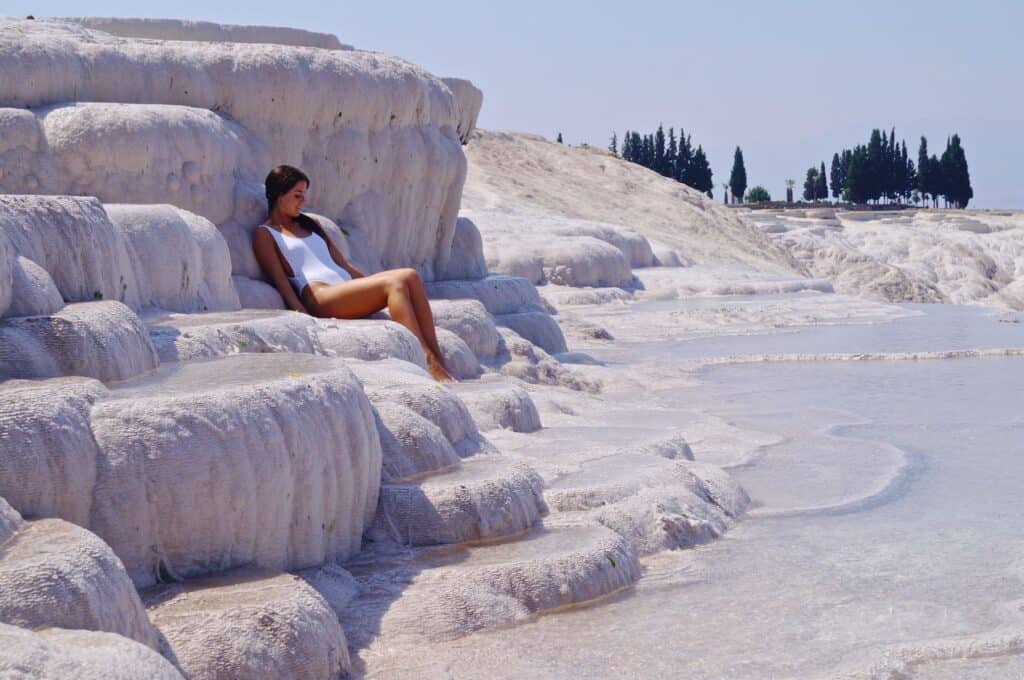Introduction
The allure of Pamukkale’s thermal pools and travertines
In the heart of Turkey lies a natural wonder that has captivated the imaginations of visitors for centuries. Pamukkale, meaning “Cotton Castle” in Turkish, is home to a series of surreal white travertine terraces, hot springs, and thermal pools. These striking formations, coupled with the ancient ruins of Hierapolis, make Pamukkale a must-visit destination for anyone traveling to Turkey.
Why visit Pamukkale thermal pools
There are several reasons why one should visit Pamukkale thermal pools. First and foremost, the otherworldly landscape is unlike anything you’ve ever seen, with shimmering turquoise pools set against a backdrop of gleaming white limestone terraces. Secondly, the thermal pools are known for their healing properties, providing a rejuvenating experience for both the body and mind. Lastly, the rich history of Hierapolis, an ancient city nestled atop the travertines, offers a fascinating journey through time.
Overview of what to expect in this blog post
In this blog post, we’ll guide you through everything you need to know for your visit to Pamukkale. From planning your trip and the best time to visit, to exploring the natural wonders and soaking in the thermal pools, we’ve got you covered. We’ll also delve into the history of Hierapolis and answer some frequently asked questions about this mesmerizing destination.
Planning Your Visit to Pamukkale

The best time to visit Pamukkale hot springs
Travertine pools, thermal springs, and southwestern Turkey are all elements that come together to create the magical experience at Pamukkale hot springs. To fully appreciate this natural wonder, it is crucial to plan your visit during the right season. Spring (April to June) and autumn (September to November) are the best times to explore these travertine pools and thermal springs in southwestern Turkey, as the temperatures are mild and the crowds are thinner.
Summer months can bring scorching heat and crowded pools, while winter offers colder temperatures and occasional snow, which may detract from your experience.
How to get to Pamukkale calcium pools
Pamukkale, with its stunning travertine pools and thermal springs, is easily accessible from various cities in Turkey. The nearest major city is Denizli, which is well connected by bus and train services. From Denizli, you can take a short 20-minute drive or hop on a local minibus (dolmuş) to reach the captivating Pamukkale calcium pools.
Things to do in Pamukkale, Turkey
Taking a day trip to Pamukkale promises a remarkable experience filled with natural beauty and historical wonder. You’ll be able to see the breathtaking travertines, or white terraces, that Pamukkale is famous for. These stunning terraces are naturally formed from thermal springs depositing calcium carbonate, creating a unique and awe-inspiring landscape that looks like it’s made from cotton – hence, its nickname, the ‘Cotton Castle’. Make sure to set out early in the morning, as this will not only allow you to fully enjoy your day, but also beat the crowds who tend to arrive later.
In addition to the travertines, the thermal pools are another must-see. These naturally heated pools offer an opportunity for a therapeutic dip and a chance to unwind amidst the striking landscape. The most famous among them is the Antique Pool, also known as the Cleopatra Pool, where you can swim among ancient Roman ruins for a truly unique experience.
The visit to Pamukkale would not be complete without immersing yourself in the rich history and cultural heritage of the area. Take some time to explore the ancient city of Hierapolis, located directly above the travertines. It’s an open-air museum that has been beautifully preserved and offers incredible insights into the region’s past.
For those with a keen interest in history and archaeology, a stop at the Hierapolis Archaeology Museum should be on your itinerary. This museum houses a collection of artifacts from Hierapolis and the surrounding areas, providing a deep dive into the ancient civilizations that once thrived here.
The pools of Pamukkale

Pamukkale white terraces: A natural wonder in Turkey
The Pamukkale white terraces are a geological marvel, formed over thousands of years by the deposition of calcium carbonate from the area’s hot springs. The resulting travertines resemble cascading cotton or snow, creating a striking contrast against the surrounding landscape.
Pamukkale natural pools: An oasis of relaxation
The Pamukkale natural pools provide the perfect spot to unwind and soak in the warm, mineral-rich waters. Each pool is unique, with some boasting stunning views of the surrounding area, while others are tucked away in hidden corners, offering a more intimate experience.
Pamukkale travertines: A unique geological formation
The travertines in Pamukkale are an extraordinary sight, resembling frozen waterfalls and terraces made of cotton. These unique formations are the result of the calcium-rich waters flowing from the hot springs, depositing calcium carbonate over time. As you wander along the travertines, marvel at the remarkable power of nature that has created this unforgettable landscape.
Swimming and Soaking in Pamukkale

Pamukkale thermal baths: Soaking in healing waters
The thermal baths of Pamukkale are not just a visual treat, but also a haven for relaxation and rejuvenation. The warm, mineral-rich waters are known for their therapeutic properties, soothing tired muscles and promoting overall well-being. Take a dip in these healing waters, and let the stresses of everyday life melt away.
Swimming in Pamukkale Cleopatra pool: What you need to know
The Cleopatra Pool, also known as the Antique Pool, is a popular spot for swimming in Pamukkale. This natural pool is believed to have been a gift from Marc Antony to Cleopatra, and its warm waters are said to have healing properties. The pool is filled with ancient marble columns, creating a unique swimming experience. There is an entrance fee to access the Cleopatra Pool, and it is not included in the general admission ticket for Pamukkale and Hierapolis.
Pamukkale hot springs: A rejuvenating experience
The hot springs at Pamukkale offer a rejuvenating experience like no other. With temperatures ranging between 35-100°C, these springs are known for their rich mineral content and therapeutic properties. As you soak in the warm waters, take in the stunning surroundings and feel your body and mind being revitalized.
Uncovering History at Hierapolis
Exploring Hierapolis Pamukkale: A journey through history
Perched atop the travertines of Pamukkale, the ancient city of Hierapolis offers a fascinating glimpse into the past. Wander through the well-preserved ruins, visit the stunning amphitheater, and explore the Necropolis, the largest ancient cemetery in Anatolia. Don’t miss the Hierapolis Archaeology Museum, which houses a vast collection of artifacts from the city’s storied past.
Hierapolis ancient city: A UNESCO World Heritage Site
In 1988, Hierapolis and Pamukkale were collectively inscribed as a UNESCO World Heritage Site, recognizing their outstanding universal value. The ancient city of Hierapolis, founded in the 2nd century BC, was an important center of healing and culture in the Roman and Byzantine eras, drawing people from far and wide to its famed thermal baths.
Cotton Castle Pamukkale: The story behind the name
The name “Pamukkale” translates to “Cotton Castle” in Turkish, and it’s easy to see why. The gleaming white travertines and terraces resemble billowing cotton or snow, creating an ethereal and enchanting landscape. As you explore Pamukkale, let your imagination run wild, and immerse yourself in the magic of this extraordinary destination.
Conclusion
Recap of the Pamukkale experience
Pamukkale is a truly unforgettable destination, offering a unique blend of natural beauty, relaxation, and historical intrigue. From the mesmerizing travertines and thermal pools to the ancient city of Hierapolis, there is something for everyone in this enchanting corner of Turkey.
Encouraging readers to plan their trip to Pamukkale
If you haven’t already, now is the time to start planning your trip to Pamukkale. With its surreal landscapes, healing waters, and rich history, this Cotton Castle is waiting to be explored. So pack your bags, grab your camera, and embark on a journey that will leave you with memories to last a lifetime.
FAQs
Yes, there is an entrance fee to access both Pamukkale and Hierapolis. The combined ticket allows you to explore the travertines, thermal pools, and the ancient city of Hierapolis. Note that the Cleopatra Pool requires a separate entrance fee and is not included in the general admission ticket.
While you can’t swim in every single pool at Pamukkale due to conservation efforts, there are designated areas where visitors can wade and soak in the thermal waters. Always follow the rules and guidelines posted at the site to ensure the preservation of this unique natural wonder.
Yes, there are numerous hotels, guesthouses, and other accommodations available in Pamukkale and the nearby town of Denizli. You can find options to suit various budgets and preferences, from luxury resorts to budget-friendly lodgings.
When packing for your visit to Pamukkale, be sure to include comfortable walking shoes, sunscreen, a hat, and sunglasses to protect yourself from the sun. Additionally, bring a swimsuit, a towel, and a reusable water bottle for your visit to the thermal pools. In cooler months, pack layers to stay warm, as temperatures can drop significantly in the evenings.
To preserve the delicate travertines and thermal pools, certain restrictions apply when visiting Pamukkale. For example, visitors must remove their shoes when walking on the travertines to prevent damage. Also, adhere to designated pathways and follow any posted guidelines to ensure the continued conservation of this natural wonder.
We recommend allocating at least one full day to explore Pamukkale and Hierapolis thoroughly. This will allow you ample time to take in the travertines, soak in the thermal pools, and discover the ancient city of Hierapolis. If you have more time, consider staying overnight to witness the stunning sunsets and sunrises over the Cotton Castle.

3 Comments